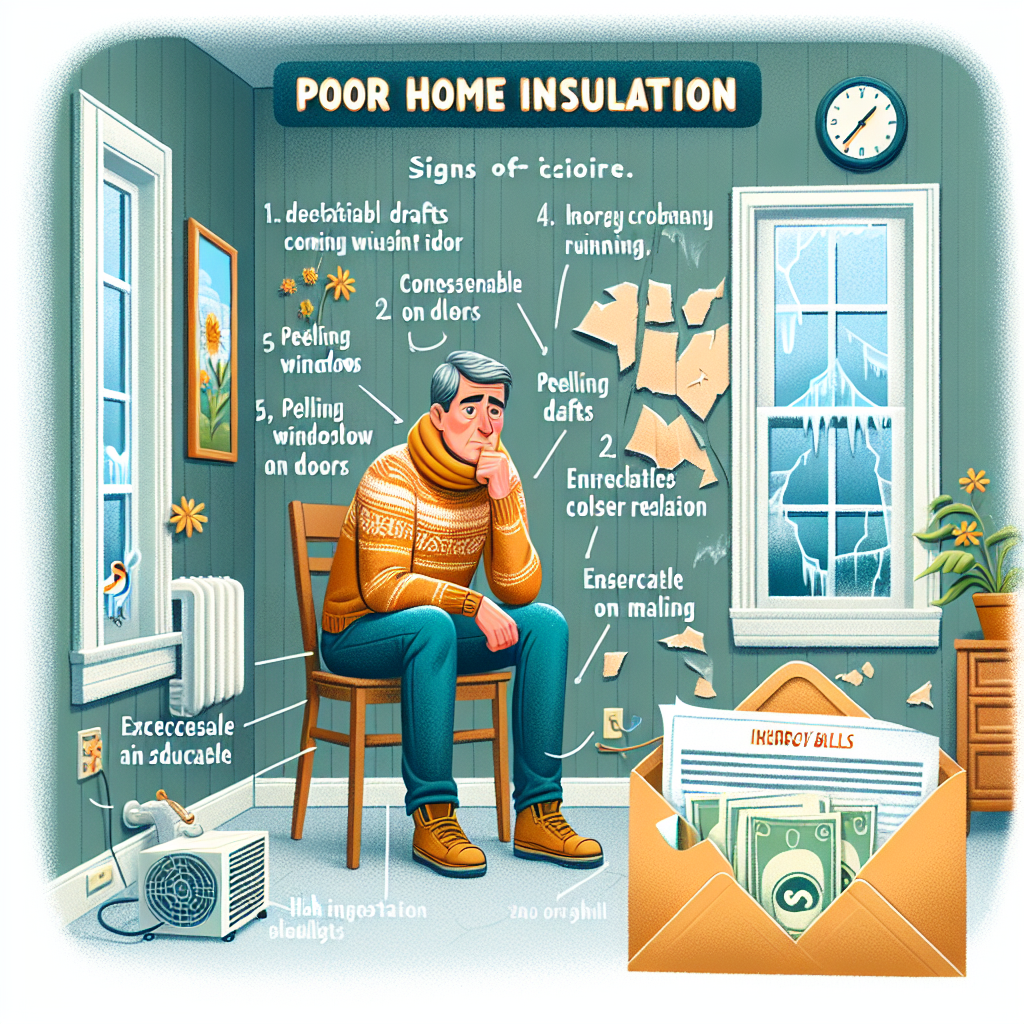Signs of Poor Home Insulation
-
Table of Contents
Poor home insulation can lead to a variety of issues that affect both comfort and energy efficiency. Recognizing the signs of inadequate insulation is crucial for homeowners looking to maintain a comfortable living environment and reduce energy costs. Common indicators include uneven temperatures throughout the house, high energy bills, drafts, and cold walls or floors. Additionally, ice dams on the roof, excessive noise from outside, and moisture problems such as mold or mildew can also signal insufficient insulation. Identifying these signs early can help homeowners take corrective measures to improve insulation, thereby enhancing the overall quality and efficiency of their home.
Identifying Drafts and Cold Spots in Your Home
Identifying drafts and cold spots in your home is crucial for maintaining a comfortable living environment and ensuring energy efficiency. Poor home insulation can lead to a variety of issues, including increased energy bills, discomfort, and even potential health risks. Recognizing the signs of inadequate insulation can help homeowners take the necessary steps to address these problems and improve their home’s overall performance.
One of the most common indicators of poor insulation is the presence of drafts. Drafts are often felt as cold air seeping into the home, particularly around windows, doors, and other openings. These drafts can be caused by gaps or cracks in the building envelope, which allow outside air to infiltrate the interior space. To identify drafts, homeowners can perform a simple test using a lit candle or incense stick. By moving the flame or smoke around the edges of windows and doors, any noticeable flickering or movement can indicate the presence of a draft. Additionally, feeling for cold air with your hand can also help pinpoint drafty areas.
Cold spots within a home are another telltale sign of poor insulation. These areas often feel significantly cooler than the rest of the house, indicating that heat is escaping or cold air is entering. Cold spots can be found in various locations, such as near exterior walls, in corners, or around electrical outlets. To identify these areas, homeowners can use an infrared thermometer or thermal imaging camera, which can detect temperature variations on surfaces. By scanning the walls, floors, and ceilings, it becomes easier to locate areas with insufficient insulation.
Furthermore, uneven heating or cooling throughout the home can also suggest insulation issues. If certain rooms or areas consistently feel warmer or cooler than others, it may be due to inadequate insulation in specific parts of the house. This can lead to an overworked HVAC system, resulting in higher energy consumption and increased utility bills. Homeowners should pay attention to temperature discrepancies and consider having a professional energy audit conducted to assess the insulation levels and identify any problem areas.
Another sign of poor insulation is the presence of condensation or moisture buildup on windows and walls. When warm, moist air comes into contact with cold surfaces, it can lead to condensation, which can eventually cause mold and mildew growth. This not only affects the structural integrity of the home but also poses health risks to its occupants. Proper insulation helps maintain consistent indoor temperatures, reducing the likelihood of condensation and moisture-related issues.
In addition to these signs, homeowners may also notice an increase in noise levels within their home. Insulation not only helps regulate temperature but also acts as a sound barrier. If external noises, such as traffic or neighborhood activities, are more noticeable inside the home, it could indicate that the insulation is insufficient or deteriorating. Upgrading insulation can significantly improve soundproofing and create a quieter, more peaceful living environment.
In conclusion, identifying drafts and cold spots in your home is essential for maintaining comfort and energy efficiency. By recognizing the signs of poor insulation, such as drafts, cold spots, uneven heating or cooling, condensation, and increased noise levels, homeowners can take proactive measures to address these issues. Investing in proper insulation not only enhances the overall performance of the home but also contributes to long-term energy savings and a healthier living environment.
Recognizing High Energy Bills as a Sign of Poor Insulation

High energy bills can often be a clear indicator of poor home insulation. When a home is inadequately insulated, it struggles to maintain a consistent internal temperature, leading to increased energy consumption. This inefficiency is most noticeable during extreme weather conditions, such as the peak of summer or the depths of winter, when heating and cooling systems must work overtime to compensate for the loss of conditioned air. Consequently, homeowners may observe a significant spike in their energy bills during these periods, which can be a telltale sign that their insulation is not performing as it should.
Moreover, the relationship between high energy bills and poor insulation is not always immediately apparent. Many homeowners may attribute rising energy costs to external factors such as fluctuating utility rates or increased usage. However, it is essential to consider the role that insulation plays in energy efficiency. Insulation acts as a barrier that slows the transfer of heat between the inside and outside of a home. When this barrier is compromised, either due to insufficient insulation or deteriorated materials, the home’s heating and cooling systems must compensate for the loss, leading to higher energy consumption and, consequently, higher bills.
In addition to high energy bills, other signs can help identify poor insulation. For instance, uneven temperatures within the home can be a significant indicator. If certain rooms are consistently warmer or cooler than others, it suggests that the insulation in those areas may be lacking. This uneven distribution of temperature forces heating and cooling systems to work harder to achieve a uniform climate throughout the home, further driving up energy costs. Additionally, drafts and cold spots near windows, doors, and other openings can also signal inadequate insulation, as these areas are common points of heat loss.
Furthermore, the age of the home can be a contributing factor to poor insulation. Older homes, in particular, may not have been built with modern insulation standards in mind. Over time, insulation materials can degrade, settle, or become less effective, leading to increased energy consumption. Homeowners of older properties should be especially vigilant in monitoring their energy bills and considering the potential need for insulation upgrades.
Another aspect to consider is the type of insulation used in the home. Different materials have varying levels of effectiveness, and some may be more prone to degradation than others. For example, fiberglass insulation, while commonly used, can lose its effectiveness if it becomes compressed or wet. On the other hand, spray foam insulation tends to provide a more airtight seal but can be more expensive to install. Understanding the type of insulation in place and its potential weaknesses can help homeowners make informed decisions about necessary improvements.
In conclusion, recognizing high energy bills as a sign of poor home insulation requires a comprehensive understanding of how insulation impacts energy efficiency. By considering factors such as uneven temperatures, drafts, the age of the home, and the type of insulation used, homeowners can better identify potential issues and take appropriate action. Addressing poor insulation not only helps reduce energy costs but also contributes to a more comfortable and sustainable living environment. Therefore, it is crucial for homeowners to remain vigilant and proactive in assessing and improving their home’s insulation.
Understanding the Impact of Uneven Temperature Distribution
Understanding the impact of uneven temperature distribution in a home is crucial for maintaining comfort and energy efficiency. One of the primary indicators of this issue is poor home insulation. When insulation is inadequate or improperly installed, it can lead to significant temperature disparities between different areas of the house. This not only affects the overall comfort of the living environment but also has broader implications for energy consumption and utility costs.
One of the most noticeable signs of poor home insulation is the presence of cold or hot spots within the home. For instance, you might find that certain rooms are consistently colder in the winter or warmer in the summer compared to the rest of the house. This uneven temperature distribution often results from gaps or insufficient insulation in the walls, attic, or floors. As a result, conditioned air escapes more easily, and outdoor air infiltrates the living spaces, making it difficult to maintain a consistent indoor temperature.
Another indicator of poor insulation is the frequent cycling of heating and cooling systems. When a home is well-insulated, the HVAC system operates more efficiently, maintaining the desired temperature with minimal effort. However, in a poorly insulated home, the system must work harder and run more frequently to compensate for the heat loss or gain. This not only leads to increased wear and tear on the equipment but also results in higher energy bills. Homeowners may notice that their utility costs are disproportionately high compared to similar homes in their area, which can be a red flag for insulation issues.
Additionally, drafts are a common symptom of inadequate insulation. If you feel a noticeable draft near windows, doors, or electrical outlets, it is likely that there are gaps in the insulation or sealing. These drafts can make certain areas of the home uncomfortable and contribute to the uneven temperature distribution. Addressing these gaps by adding weatherstripping or caulking can help mitigate the problem, but a comprehensive insulation assessment may be necessary to identify and rectify all sources of air leakage.
Condensation and moisture problems can also signal poor insulation. Inadequate insulation can lead to temperature differentials that cause condensation to form on walls, ceilings, and windows. Over time, this moisture can lead to mold growth, which poses health risks and can damage the structural integrity of the home. Homeowners may notice water stains, peeling paint, or a musty odor, all of which are indicative of moisture issues related to poor insulation.
Furthermore, fluctuating indoor temperatures can affect the overall comfort and health of the home’s occupants. Inconsistent temperatures can lead to discomfort, making it difficult to relax or sleep. For individuals with respiratory issues or allergies, poor insulation can exacerbate symptoms by allowing allergens and pollutants to enter the home more easily. Ensuring that the home is properly insulated can create a more stable and healthy living environment.
In conclusion, recognizing the signs of poor home insulation is essential for addressing uneven temperature distribution and improving overall comfort and energy efficiency. Cold or hot spots, frequent HVAC cycling, drafts, condensation, and fluctuating indoor temperatures are all indicators that insulation may be inadequate. By identifying and addressing these issues, homeowners can create a more comfortable, energy-efficient, and healthy living space.
Read more about Home Insulation
- Types of Home Insulation
- Benefits of Home Insulation
- Choosing the Right Insulation for Your Home
- Common DIY Home Insulation Mistakes
- Insulation for Different Areas of Your Home
- Home Insulation ROI (Return on Investment)
- How to Improve Home Insulation without Breaking the Bank
- Upgrading Home Insulation for Extreme Climates
- Maintaining and Updating Home Insulation








